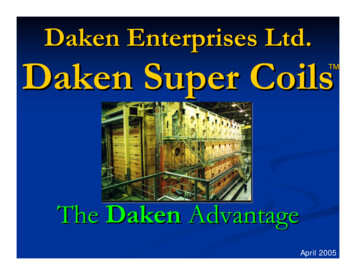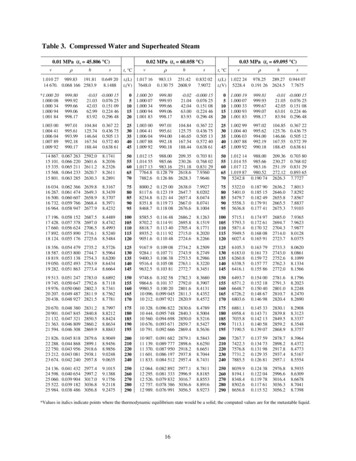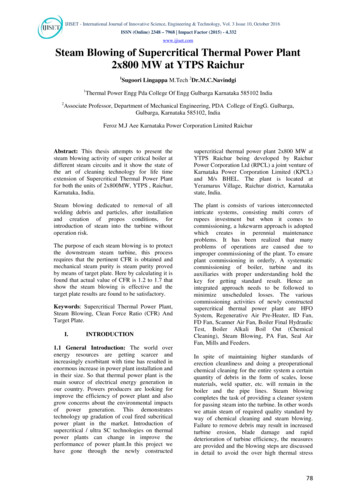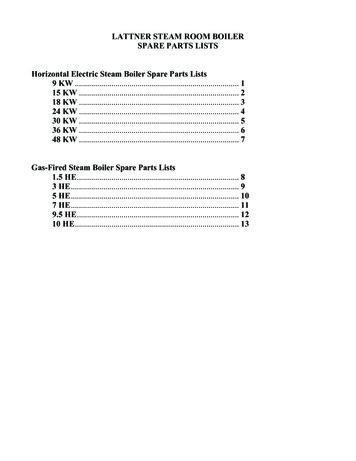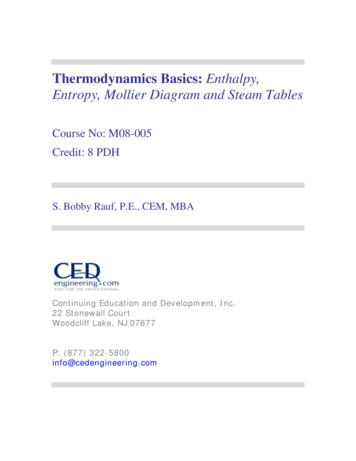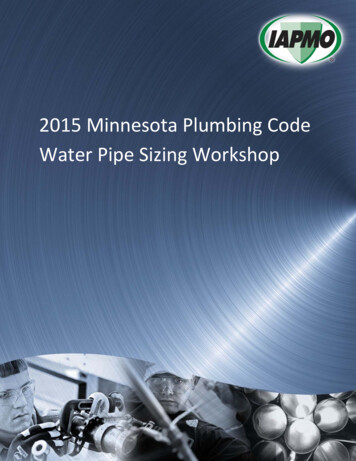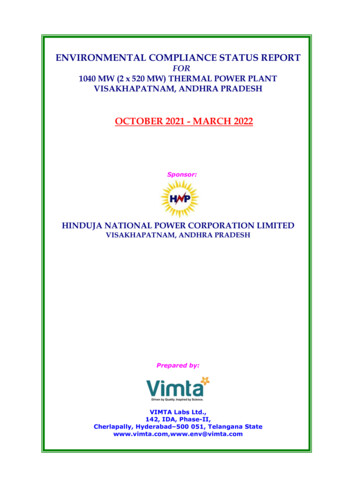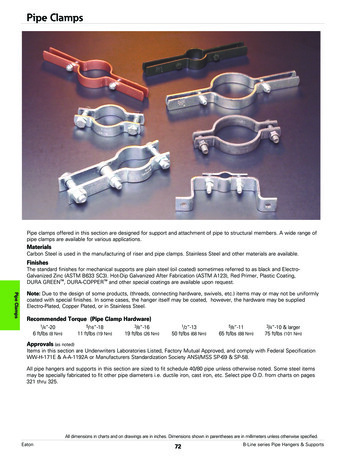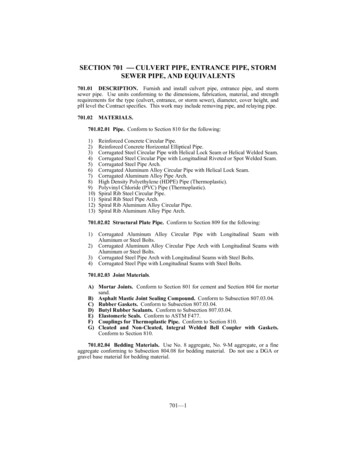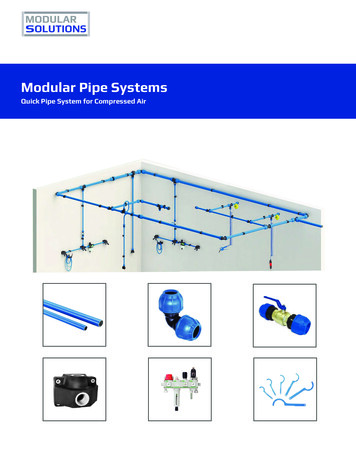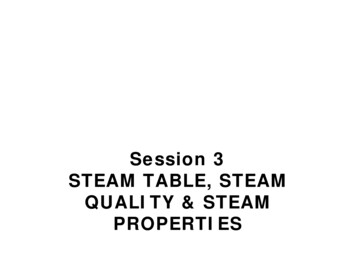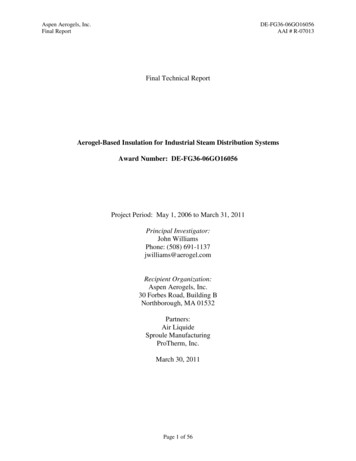
Transcription
Aspen Aerogels, Inc.Final ReportDE-FG36-06GO16056AAI # R-07013Final Technical ReportAerogel-Based Insulation for Industrial Steam Distribution SystemsAward Number: DE-FG36-06GO16056Project Period: May 1, 2006 to March 31, 2011Principal Investigator:John WilliamsPhone: (508) 691-1137jwilliams@aerogel.comRecipient Organization:Aspen Aerogels, Inc.30 Forbes Road, Building BNorthborough, MA 01532Partners:Air LiquideSproule ManufacturingProTherm, Inc.March 30, 2011Page 1 of 56
Aspen Aerogels, Inc.Final ReportDE-FG36-06GO16056AAI # R-07013Acknowledgment:This report is based upon work supported by the U. S. Department of Energy under Award No.DE-FG36-06GO16056.Disclaimer:Any findings, opinions, and conclusions or recommendations expressed in this report are thoseof the author(s) and do not necessarily reflect the views of the Department of Energy.Page 2 of 56
Aspen Aerogels, Inc.Final ReportDE-FG36-06GO16056AAI # R-07013Table of ContentsList of Acronyms . 4Lists of Figures . 5List of Tables . 71. Executive summary. 82. Introduction. 92.1.Energy Benefits, Economic Viability and Environmental Benefits . 112.1.1.Energy Benefits. 112.1.2.Environmental Benefits . 122.2.Industry Involvement and Commercialization Plan . 123. Background . 134. Results & Discussion. 144.1.Material Development . 144.1.1.System Requirements. 144.1.2.Fire Performance. 154.1.3.Dimensional Stability. 184.1.4.Water Resistance/Permeability . 194.1.5.Corrosion Performance . 204.1.6.Other Testing . 214.2.Product Improvement and Cost Reduction Activities . 254.2.1.Hydrophobe Retention . 254.2.2.Fiber Reinforcement . 274.2.3.Lattice Strength at High Temperatures . 274.2.4.Manufacturing Process Scale Up . 274.2.5.Installation of Unit Operation for Pyrogel XT Additive during Casting . 284.2.6.Blanket Casting Optimization. 284.2.7.Increasing Throughput of Pyrogel XT in Aging. 294.3.Industry Acceptance Activities . 294.3.1.Product Expansion . 294.3.2.Product Demonstration at Industrial Sites . 295. Benefits Assessment . 506. Commercialization. 517. Accomplishments . 528. Conclusions. 549. Recommendations. 5510. References. 563
Aspen Aerogels, Inc.Final ReportDE-FG36-06GO16056AAI # R-07013List of ased pipe insulationAmerican Society for Testing MaterialsBritish Thermal UnitCorrosion under insulationDepartment of EnergyEnergy Savings CompanyEnergy Savings Performance ContractFlame Spread IndexfeetgallonhourIsolectronic pointsinchInfraredInternational Standardization OrganizationIndustrial Technologies ProgrampoundsNational Fire Protection AssociationmillimeterMillion BTUsmiles per hourNaval Stationpounds per square inchSmoke Developed IndexTrillion BTUsThermal ConductivityUnderwriters Laboratoriesyear4
Aspen Aerogels, Inc.Final ReportDE-FG36-06GO16056AAI # R-07013Lists of FiguresFigure 1. Estimated US industrial steam pipe population by diameter and temperature. 11Figure 2. ABPI two-pronged market penetration strategy developed at the project start. 12Figure 3. Test results from small scale UL 1709 screening tests performed in June, 2008. . 17Figure 4. Comparative performance in a UL1709 fire test. 17Figure 5. Average mid-thickness and surface temperatures of Pyrogel XT (48mm) upon hotinstallation at a temperature of 1080 F. 19Figure 6. Average surface and mid-thickness temperatures as a function of time for Pyrogel XT(60 mm) when hot installed at a temperature of 1200 F. . 19Figure 7. A photograph depicting the apparatus (left) and aerogel coupons (right) used to assessASTM C692 performance. 21Figure 8. Interply temperatures as a function of time for Pyrogel XT (500ºC, 40mm). 22Figure 9. Interply temperatures as a function of time for Pyrogel XT (400C, 30mm). 22Figure 10. Water repellency of material as a function of ply number and mean exposuretemperature after 68-day testing. . 23Figure 11. Extractable pH as a function of ply number and mean exposure temperature after 68day testing. . 24Figure 12. Extractable anion content as a function of ply number and its relation to extractablepH values. . 24Figure 13. Thermal conductivity (37.5 ºC, 1 atm) and water repellency as a function of plynumber after 68-day testing. . 25Figure 14. Hydrophobicity (water uptake) and thermal conductivity (Tc) of Pyrogel XT(laboratory prepared) as a function of water content in aging. . 26Figure 15. Improvements in hydrophobicity for Pyrogel XT as a function of hydrophobeplasticizer content. . 27Figure 16. Aspen Aerogels’ current flexible blanket manufacturing process. . 28Figure 17. In Service Demonstration Installs . 30Figure 18. Insulation overwrap concept. 31Figure 19. IR Survey. 31Figure 20. Installation Site. 31Figure 21. Field Installation and Instrumentation. 32Figure 22. Crimped and Sealed Edges . 32Figure 23. Insulated Pipe Support. 33Figure 24. A) Wide view of NS Newport showing boiler location and proposed steam lineinstallation site and B) close up of installation site behind Bldg 1. 34Figure 25. A) bare pipe in maintenance cabinet, B) IR image shows 390ºF surface temperature. 35Figure 26. A) Visual image of break in trough cover with pipe underneath on North side ofinstallation site, and B) infrared image of pipe with 165ºF surface temperature. 35Figure 27. A) Visual image pipe central to the installation site, and B) infrared image of pipewith 211ºF surface temperature. . 36Figure 28. Pipe obstructions encountered in the trench such as this intersecting water line. 37Figure 29. Data monitoring schematic - thermocouples were place in same locations at start andend of installation section. . 38Figure 30. Pipe section (A) before and (B) after application of cellular glass . 385
Aspen Aerogels, Inc.Final ReportDE-FG36-06GO16056AAI # R-07013Figure 31. Pyrogel XT Aerogel Insulated Test Section Temperature and Mass Flow Plot. 39Figure 32. Heat Loss (BTU/ft-hr)/ at the Inlet and Outlet of Pyrogel Test Section . 40Figure 33. Gluten drying equipment in Marshall, MN. . 41Figure 34. Installation of Pyrogel XT on various sections of ductwork. . 42Figure 35. Depiction of pipe installation at ExxonMobil Port Jerome Gravenchon, includingelbows and vertical elements. . 43Figure 36. Installation site with pre-existing mineral wool insulation still on the pipe. 44Figure 37. Pyrogel installation on straight section. 44Figure 38. Fitting a lobster tail elbow section on a 90º elbow at Port Jerome. 44Figure 39. Fitting a lobster tail elbow section on a 45º elbow at Port Jerome. 45Figure 40. Thermocouple placement on 8" pipe installation. . 45Figure 41. Installation of Pyrogel XT on “bullet” tank at Port Jerome Refinery: a) full tankimage and b) close up of aerogel installation in progress. 46Figure 42. Workers installing Pyrogel XT on a bullet tank: a) top half, b) bottom half. . 46Figure 43. PGXT valve cover installation (A) and glass mat valve covers (B) at Pastore Centerin Providence, RI. . 47Figure 44. Pyrometer reading and infrared imaging of glass mat valve cover . 47Figure 45. Pyrometer reading and infrared imaging of Pyrogel XT valve cover . 48Figure 46. Measured thickness of in-use section of 1" glass mat shows the material compressedto 0.78”. 496
Aspen Aerogels, Inc.Final ReportDE-FG36-06GO16056AAI # R-07013List of TablesTable 1. Status of performance requirements for second spriral of development . 14Table 2. ASTM E84 Test Results . 15Table 3. ASTM E1559 water wicking results observed for Pyrogel XT. 20Table 4. ASTM C795 results for Pyrogel XT (BLKT1205). 21Table 5. Test data and analysis from overwrap trial at Air Liquide. . 33Table 6. Potential savings achieved with Pyrogel XT installation on 300 ft pipe section. 36Table 7. Predicted Performance of Insulation Materials Used at NS Newport . 40Table 8. Summary Table of Measured Insulation Performance at NS Newport . 41Table 9. Design calculations for insulation of 8" pipe at ExxonMobil, Port Jerome. . 43Table 10 . Measured and calculated* (with 3EPlus) temperature of glass mat vs. Pyrogel XTvalve cover . 487
Aspen Aerogels, Inc.Final Report1.DE-FG36-06GO16056AAI # R-07013Executive summaryThe innovations addressed in this project revolve around an aerogel-based thermal insulationsystem applied to industrial steam distribution systems. Thermal losses in this area in the USalone accounts for 977 trillion Btu/year, more than 1% of total domestic energy consumption.1The successful deployment of this technology into the industrial marketplace could produceannual energy savings of 149 trillion Btu’s by the year 2030.Aspen Aerogels worked with DOE’s Industrial Technologies program from 2006-2010 tospecify, develop, scale-up, and deliver Pyrogel XT , an aerogel-based pipe insulation (ABPI), tomarket to reduce the energy loss experience in industrial steam processing systems. The productdeveloped has become Aspen’s best selling flexible aerogel blanket insulation, with sales inexcess of 20 MM square feet of material as of the end of 2010. These sales of Pyrogel XT byAspen have led to over 60 new jobs (mainly in manufacturing) since the project began.Additionally, and very importantly, this product has, so far, delivered more than an estimated0.537 TBTU of energy savings to the nation based on industrial installations of Pyrogel XT. Thecommercial success is based on the value proposition for the Pyrogel XT product, that it deliversbetter thermal performance, improved durability, and faster installation times than the incumbentinsulation materials used in industrial steam applications.The project work was initiated by thoroughly defining the insulation product requirements forthe targeted industrial steam line market. Then it validated which of the requirements werealready met by the existing aerogel insulation material previously developed by Aspen Aerogels.Subsequent work focused on improving the aerogel blanket insulation to withstand the hightemperature environment and provide excellent thermal performance at those conditions.Specifically, the aerogel insulation blanket fiber reinforcement material was optimized forperformance and cost, the hydrophobic agents which prevent corrosion under insulation weremodified, and the aerogel phase of the blanket was strengthened. In parallel to the productdevelopment, manufacturing throughput of Pyrogel was increased significantly throughextensive optimization of the process steps of additive incorporation into the aerogel phase of theblanket, improvement in casting aerogel precursors into the fiber blanket substrate, andoptimization of aerogel aging in the gelled blanket. Additionally, Aspen Aerogels developedcomplimentary aerogel products to offer a complete pipe insulation system. This was done byworking with its partner, Sproule Manufacturing, which designed aerogel coverings for pipeelbows, pipe flanges, and small bore pipes which speed installation and ensure proper fit. Now acomplete line of Pyrogel XT products is available to match most standard pipe sizes.Finally, the product was demonstrated and documented at 5 facilities. The 3 industrial sitesincluded Air Liquide (LaPorte, TX), ExxonMobil (Port Jerome, FRANCE), and Archer DanielsMidland (Marshall, MN); and the 2 government installations were the Pastore Center(Providence, RI) and Naval Station Newport (RI). These demonstrations validated Pyrogel XT’ssuperior performance and cost savings relative to incumbent insulation materials.This investment by DOE has paid back at least 30-fold in product sales to date, created dozens ofU.S. manufacturing jobs, and contributed tens of millions of dollars of exports to the U.S.economy.8
Aspen Aerogels, Inc.Final Report2.DE-FG36-06GO16056AAI # R-07013IntroductionThe overall goal of this project was to reduce domestic energy consumption and bolster USexports by developing a revolutionary thermal insulation material – aerogel – for industrial steamsystems. This goal was pursued according to a three-pronged approach:1. development of a set of performance objectives, and the formulation of a basic materialarchitecture that would meet those objectives.2. product improvements to meet the performance targets and process development reducethe cost of the base material to the point where it was economically competitive with theother players in the market.3. commercial activities to achieve industry acceptance, including the development ofcomplimentary products, literature and training materials, and conducting demonstrationprojects. Partners in these field demonstrations of aerogel insulation included AirLiquide, ProTherm, Sproule Manufacturing, ExxonMobil, Archer-Daniels Midland, andNewport Naval Station.Aerogel, formed of intricate networks of nanoporous silica, possess the lowest thermalconductivity of any known solid. Although this material has been used everywhere fromplanetary spacecraft to particle accelerators, it is only recently that it has become cheap enoughand strong enough to be considered for industrial applications. Industrial steam distributionsystems loss energy via heat loss through pipes, valves, traps, and other line components.Thermal losses in this area alone accounts for 977 trillion Btu/year, more than 1% of totaldomestic energy consumption.In 2006, Aspen Aerogels competitively won an R&D award from the Department of Energy’sIndustrial Technologies Program to deliver an aerogel-based pipe insulation (ABPI) to marketwith the goal of reducing the energy loss in these systems. This work culminated in thedevelopment and commercial deployment of Pyrogel XT, Aspen Aerogels’ best selling flexibleaerogel blanket insulation. To date, this product has delivered more than 0.5 TBTU of energysavings to the nation. It is applied to pipes similarly to incumbent technologies such as mineralwool, fiberglass, calcium silicate, perlite, and various foams; however, Pyrogel XT deliversbetter thermal performance, improved durability, and faster installation times than theincumbents. The record-low thermal conductivity of aerogel, coupled with a strong geometriceffect in systems with radial heat flow, enables the insulation to provide equal thermal resistancewith 65-95 percent less material. Furthermore, the correspondingly smaller surface area losesless heat through radiation and convection, even at the same touch temperature (typically 120140 F).Pyrogel XT relies on the same field-proven design architecture as existing pipe insulationproducts. It consists of one or more layers of insulating material applied to the hot pipe surface.These layers are sold in standard thickness increments of 5mm and 10mm. The insulation is thenencapsulated by a weather and abrasion resistant overwrap, and mechanically secured in placewith circumferential fasteners. Tight fitting lap joints between adjacent parts prevents waterinfiltration and thermal shunting. In certain circumstances, mastic, caulk, or pressure-sensitivetape can be applied to the joint areas to increase the level of protection. However, Aspen’s9
Aspen Aerogels, Inc.Final ReportDE-FG36-06GO16056AAI # R-07013aerogel blankets are both durably hydrophobic, and water vapor permeable. This ensures that ifwater does penetrate the envelope, it will neither damage the insulation, nor get trapped inside.The benefits of ABPI to the US industrial sector include: Reduced Energy Usage: Aerogel’s low conductivity allows thinner insulation; thinnerinsulation provides less surface area; and less surface area reduces heat loss. For typicalpipe insulation applications, the magnitude of this savings will range from 5-40%,representing a considerable costs savings to the plant operator, and a reduction indomestic energy consumption estimated at 149 trillion Btu per year by 2030.Lower Material Costs: Although aerogel is likely to remain more expensive per unitvolume than fibrous products, its 30-90% lower conductivity means that far less materialmust be used for a given level of thermal protection. This means that aerogel is the lowcost solution for pipe diameters below 6”.Lower Installation Costs: The combination of a thin material and high strain-to-failuremeans that aerogel can be rolled on-site to conform to all but the smallest pipe diameters.This enables a one-step installation process in which the aerogel is pre-bonded to themetal sheathing, and the integrated unit is snapped into place and secured. Labor savingsfrom this aspect alone are typically to be in the range of 30-50%.Smaller Logistical Footprint: Aspen’s flexible blanket form of aerogel allows thematerial to ship as a flat stack or on a spool, as opposed to the industry standard of preformed annular parts nested in a box. Between that and its intrinsically lower materialvolume, ABPI requires considerably less shipping and subsequent handling on the jobsite. For example, on a 4 inch pipe requiring 2 inches of calcium silicate insulation, thirtypallets (48x48x60 inches) are required for every linear mile. Aerogel would provide thesame level of thermal protection with just 4 pallets.Lower Total Cost-of-Ownership: Lower installation costs, lower shipping costs, andconsistent thermal performance of the material of its lifecycle translate to lower cash outof-pocket for steam system operators wishing to upgrade their thermal protection. That,coupled with dramatic and enduring energy savings, has produced the type of totalownership-costs to garner the rapid and widespread adoption of Pyrogel XT.Long Term Water Resistance: Unlike calcium silicate, fiberglass, and some foams,Pyrogel XT is durably and strongly hydrophobic. In addition, its porous structure andvapor transmission characteristics allow it to dry out rapidly, even after prolongedsubmersion. This has been illustrated convincingly through performance testingperformed during the execution of this project.Corrosion Under Insulation (CUI): Because of Pyrogel’s ability to wick water awayfrom hot pipes, the wet and warm conditions that often lead to corrosion can beprevented. Further, aerogel’s chemical stability and composition ensure that it will notdecompose into corrosive by-products. It may even be possible, later in the developmentstages, to dope the aerogel material with corrosion inhibitors like sodium silicate, makingit an active defense against CUI.Passive Fire Protection: A variant of Pyrogel XT, Pyrogel XTF, can also be used forsituations in which the thermal insulation must also act as passive fire proofing.Pyrogel XTF, which is artificially colored gray to make it visually distinct fromPyrogel XT, uses a slightly modified fibrous batting to maintain its structural integrityeven during a severe, 2000 F fire event.10
Aspen Aerogels, Inc.Final ReportDE-FG36-06GO16056AAI # R-070132.1.Energy Benefits, Economic Viability and Environmental BenefitsAnalysis of both the energy and economic benefits of ABPI are predicated on assumptions aboutthe type and distribution of steam piping within US industry. As shown in Figure 1, the totalpipe inventory was parsed into discrete bins according to diameter and steam temperature. Thisanalysis is based on Aspen’s and Protherm’s estimates of relative prevalence, where the unit ofmeasure is pipe length (in miles). This assumes that US steam systems are skewed stronglytoward sub-10 inch plumbing, and sub-600 F steam temperatures.Figure 1. Estimated US industrial steam pipe population by diameter and temperature.For each of the diameter-temperature bins, 3E Plus software was used to calculate energy lossper unit length for calcium silicate, mineral wool, and aerogel-based pipe insulation. Thecalcium silicate and mineral wool values were averaged on the assumption that their aggregateenergy performance (in a 50:50 ratio) is representative of the total industry, including fiberglass,perlite, and foams. Assuming line components are a negligible contributor, the incumbent heatloss per unit length was then integrated across diameter and temperature distributions, and setequal to the steam pipe energy losses (977 trillion Btu/year) called out in Ref. 2 . The result is anestimate of approximately 160,000 miles for the total length of steam piping in US industry.(Note that a completely different approach, based on the work in Ref. 3, arrived at a similarvalue, providing a reasonable level of confidence in the result.) This value was then divided upamong the bins to enable detailed energy and economics calculations for each combination ofdiameter and temperature.Market penetration was calculated by assuming that 80 percent of the overall steam pipeinsulation market could be technically addressed by ABPI, and of that only 50 percent was likelyto be captured. This yielded an asymptotic penetration of 40 percent.2.1.1. Energy BenefitsBased on these heat loss and market penetration analyses, the annual reduction in industrialenergy consumption was estimated. Aspen calculates that if aerogel insulation was applied to11
Aspen Aerogels, Inc.Final ReportDE-FG36-06GO16056AAI # R-0701340% of the 160,000 miles of U.S. industrial steam pipes, annual energy savings of 16 trillionBritish thermal units and energy cost savings of 117 million could be achieved by 2025.2.1.2. Environmental BenefitsThe primary environmental benefit of ABPI is the reduction in atmospheric emissions due tolower energy consumption in boilers. Using typical performance metrics for industrial boilers,cumulative savings of 3.5 million tonnes carbon equivalent CO2, and 85,000 metric tonnes ofSO2 and NOx were calculated. Secondary benefits could be claimed from the manufacturing ofaerogel instead of incumbent insulation materials, based solely on the fact that aerogel-basedinsulation requires one-third to one-tenth the material for a given application. All else beingequal, less material produced means less waste generated both during production, and for end-oflife disposal. However, since little is known about incumbent manufacturing processes, all elsemay not be equal. So, for the purposes of this exercise, the net environmental impact from themanufacturing and solid waste side is conservatively assumed to be zero.2.2.Industry Involvement and Commercialization PlanAt the start of the effort, the Aspen team developed a two-pronged commercialization plan tosaturate the addressable pipe insulation market by the year 2030. As shown in Figure 2, the firstcomponent of this plan was to reduce material costs. Reduced costs would allow ABPI tocompete in larger pipe diameters, where the geometric advantage of low conductivity is not asstrong. So for example, ABPI entered the market in 2007 being competitive in pipes smallerthan 6 inches, and temperatures under 350 F – only 18 percent of the total market (in units ofpipe length). Within two years, however, the cost-reduction activities would swell thecompetitive segment of the market to 52 percent.Figure 2. ABPI two-pronged market penetration strategy developed at the project start.The other prong of the commercialization plan was to increase ABPI performance and durabilityat high temperatures. Aspen Aerogels had already made significant gains in this regard, and thework performed under this project solidified this position.12
Aspen Aerogels, Inc.Final Report3.DE-FG36-06GO16056AAI # R-07013BackgroundLittle had changed in the industrial pipe insulation market in the last 40 years. Since theintroduction of polyurethane foams in the 60’s, no major new m
Aspen Aerogels, Inc. DE-FG36-06GO16056 Final Report AAI # R-07013 Page 1 of 56 Final Technical Report Aerogel-Based Insulation for Industrial Steam Distribution Systems
